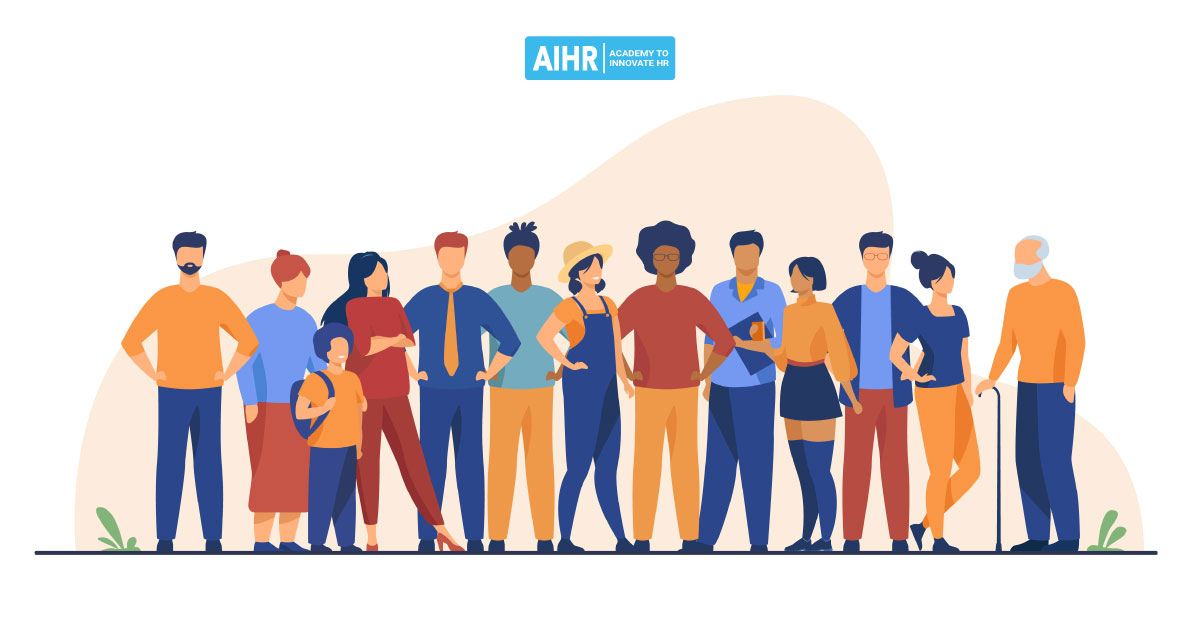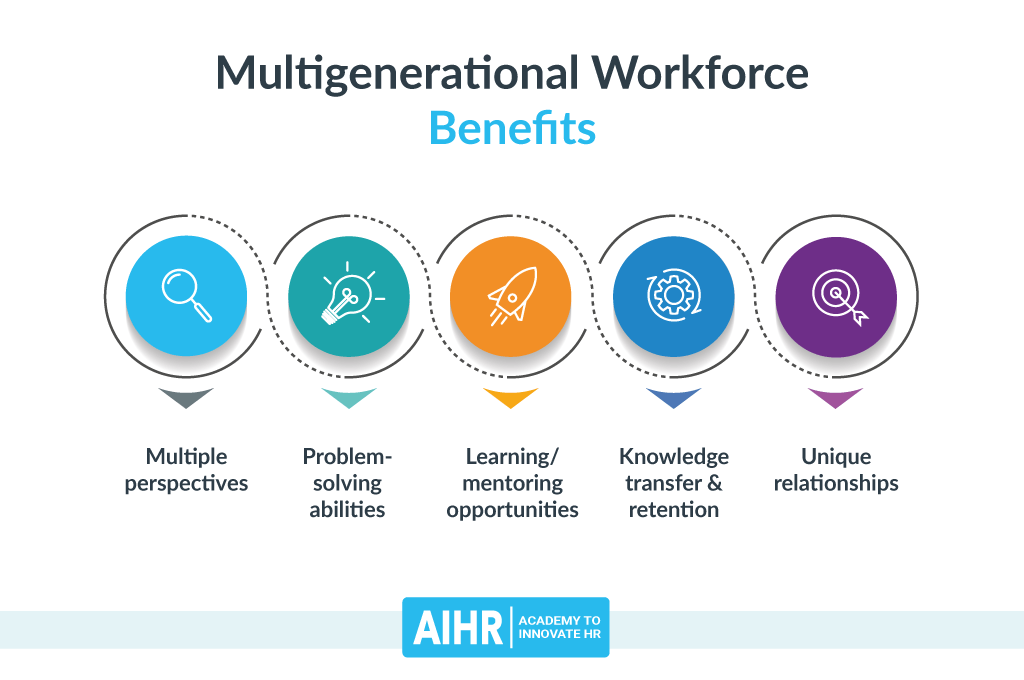Understanding Today’s Multigenerational Workforce: Benefits, Challenges, and 9 Best Management Practices

Multiple generations comprise today’s workforce, and each has varied work habits, expectations, and communication styles. Employers who implement strategies that optimize a multigenerational workforce can bolster their business goals. What strategies can your organization use to reap the benefits of a multigenerational workforce?
Contents
What is a multigenerational workforce?
Benefits of a multigenerational workforce
Multigenerational workforce challenges
Managing a multigenerational workforce – 9 best practices
What is a multigenerational workforce?
A multigenerational workforce is a personnel comprised of people from several generations. The average lifespan for humans has been increasing, so more individuals are choosing to work well past the typical retirement age.
The age diversity in the current workforce is the widest ever. It is now common for organizations to have employees working side-by-side who represent four to five generations.
These groups are defined as:
- Silent Generation (Traditionalists) – born 1928-1945
- Baby Boomers – born 1946-1964
- Generation X – born 1965-1980
- Generation Y (Millennials) – born 1981-1996
- Generation Z – born 1997-2012
The presence of multiple generations expands the pool of available talent and shifts its demographics. Still, many employers have not placed a significant focus on taking advantage of this.
HR leaders should consider all age groups during succession and strategic workforce planning to find the best ways to attract, engage, retain, and develop employees from various life stages.
Benefits of a multigenerational workforce
Including a range of ages in your staff adds value to the organization. Younger employees are accustomed to rapidly developing technology and adapting to the changes it drives. In like manner, more mature employees have knowledge from the duration of their experience that can guide decision-making. The collaboration of fresh innovation with wisdom from the experience brings increased productivity.
The following are some of the significant benefits of a multigenerational workforce:
- Multiple perspectives – Different generations can have distinctive ways of viewing job responsibilities. Sharing perspectives within and across teams brings a broad range of knowledge and abilities to support innovation.
- Problem-solving abilities – Combining multiple perspectives and diverse skills drives creative solutions to problems. Life experience influences how we relate to and interact with others to address challenges and conflict. As a result, teams with age diversity can offer a variety of ways to address problems.
- Learning/mentoring opportunities – The more diverse a team is, the more ways people have to interact and learn from each other’s insights. This includes mutually beneficial mentoring opportunities. Those with more years of experience can advise younger employees on career development. What’s more, the recent trend of reverse/cross-generational mentoring allows more junior employees to educate mature workers with their familiarity with current trends and technology.
- Knowledge transfer and retention – The awareness and strengths that each generation offers better prepare the business to meet its future leadership needs. Tacit knowledge stays within the company in a robust internal talent pipeline. Focus is more on in-house promotion and less on recruiting from the outside.
- Unique relationships – Meaningful relationships with co-workers can help meet employees’ emotional needs and contribute to job satisfaction. A variety of age groups within the organization mirrors a family structure to offer opportunities for personal connections with those outside of one’s own generation.

Multigenerational workforce challenges
Although a multigenerational workforce is advantageous overall, it does propose some obstacles to maneuver.
Here’s an overview of some of the main multigenerational workforce challenges:
- Communication issues – There are likely differences in preferred communication styles and interpretation of tone between the generations. With the availability of email, instant messaging, or phone and video calls, methods for reaching employees are plentiful. Selecting the best way to connect with team members and avoid communication breakdowns requires careful consideration.
- Negative stereotypes – As with any type of diversity, people have preconceived notions about those in a different age group. Older generations may assume that younger people are entitled, oversensitive “snowflakes.” Youthful employees may presume that those that are older than them are inflexible and afraid to embrace technology. These sweeping generalizations form negative stereotypes that might lead to toxic company culture, disparate treatment, ageism, and legal problems.
- Varying employee expectations – People from different generations may not hold the same expectations for their employment. Ways that people accomplish their duties, learn from trainings, or expect to have their performance evaluated can vary. Also, what is considered a desirable compensation package might not be the same for each generation.
Managing a multigenerational workforce
HR is instrumental in making sure the company bridges the generational gap and has efficient, cohesive teams. How do you overcome the multigenerational workforce challenges to reap the benefits?
Here are nine management practices for leading a multigenerational workforce:
1. Work on your Employee Value Proposition (EVP)
Does your EVP appeal to the spectrum of generations? Cultural benefits can keep employees of all ages satisfied with their job. The key is offering a sought-after work environment and an assortment of perks to satisfy a variety of people.
Policies and programs for wellness, work/life balance, and paid time-off are attractive to all generations. However, providing professional development, career advancement, community service opportunities, financial investment programs, and social events can target other desires to offer a wider appeal to different ages.
2. Fine-tune your inclusive hiring process
From sourcing to offer, you should strive to eliminate age bias when recruiting. Start with educating hiring personnel, then expand your recruiting channels to use as many as possible. (College job fairs shouldn’t be the only place you look to fill entry-level positions.)
The wording of job ads can discourage age diversity. Check them for inclusivity. Stick to neutral language and avoid terms or phrases that target a particular generation. You should also include images and videos on your career site that show people of diverse age groups.
Dates, names, and other resume details can infer demographic information. If you are able to implement computer programs that use AI to screen, it can help you avoid these biases. Having a mix of younger and older hiring managers filter applicants and conduct interviews can also help level the field.
3. Cater to different communication styles
Harmony and productivity are dependent on effective communication. The aim is to ensure that the same information is accessible to everyone.
Language gaps have always existed between generations, but younger workers used to assimilate into their employer’s communication norms. Now that digital communication is changing culture so rapidly, younger generations have much more influence. Workplace communication has become more about meeting in the middle to find common ground and blend the varied styles.
You should have consistency in company-wide communications and certain standards when it comes to your brand voice, but you can look for ways to facilitate different styles on a smaller scale. Offer leaders their choice of text-based or video communication methods based on their teams’ needs. When it comes to one-on-ones, there should certainly be leeway for managers to address these individually.
4. Clarify and reiterate expectations
A common purpose unites people and minimizes their differences. Regardless of their age, employees want to be clear on the business goals and the specific role they are required to play in these endeavors.
Managers must establish avenues for spreading the word about expectations on an ongoing basis. They should also provide assurance about what employees can anticipate from the company as a whole and within their team.
Constructive observations from leaders help workers be accountable and enhance their skills. This type of direction assures that employees have the confidence of knowing where they’re headed.
5. Collect feedback
Not everyone is comfortable giving unsolicited opinions, so you need ways to encourage honest feedback that reveals the pulse of your multigenerational workforce. You should offer these opportunities through surveys, performance appraisals, and one-on-ones, or other creative methods.
As you learn how engaged people feel and how they are performing, you can discover what you need to improve to manage a multigenerational workforce better.
6. Accommodate diverse working styles and needs
There is no one-size-fits-all way to address how workers of any generation can perform best. Organizations that are able to adjust to their employees’ needs are more apt to attract and retain the finest of the available talent pool.
Flexible work hours can accommodate employees of all seasons of life. Offering varied schedules or part-time work allows caregivers more time with family or provides a phased-in approach to retirement.
Previously, there might have been a generational factor in the preference for virtual employment, but the COVID-19 pandemic has changed that. A broad range of people have welcomed the freedom of remote work, and employers are embracing this reality. For example, Spotify is now offering its employees the ability to ‘work-from-anywhere’. Not every industry can accommodate this type of situation, but businesses that want to compete for top talent will need to oblige.
7. Create learning opportunities
People are generally eager to expand their skills and advance their careers, and it is not limited to just younger workers. Providing a wide array of knowledge-building opportunities benefits employees’ growth and enlarges their contribution to your business. An environment where asking questions is encouraged facilitates a learning atmosphere and allows everyone to be heard.
Upskilling and reskilling aren’t only accomplished through formal trainings. It can happen through knowledge sharing between generations through peer mentoring and learning, sponsorship, or assembling cross-functional teams.
Some employees will quickly catch on to new technologies, but you should provide optional training for those who desire something more in-depth. This will boost their proficiency and confidence and ensure continuity.
8. Combat bias and stereotypes
Generational bias and stereotypes do exist. It’s far better to reframe them than pretend they aren’t there. Although it is a mistake to assume that people are “entitled,” “stubborn,” “idealistic,” or “a workaholic” just because of their age, the context of different life experiences does shape people in certain ways.
Acknowledging and contemplating differences allows you to harness the strengths of each generation. It might be necessary to conduct training to confront age-based stereotypes, such as role-playing exercises. Bringing inaccurate perceptions to the forefront makes people more aware of their assumptions and can lead to more harmonized multigenerational teamwork.
You should work on deliberately dispelling bias and stereotypes at all employee lifecycle stages. In addition to the hiring process, you must watch out for the bias in your HR and people policies and among employees and leadership approaches.
9. Nurture an inclusive environment at work
Employers are certainly making a strong effort to create work environments that are inclusive to everyone, but age diversity may be the most overlooked concept. You must take ageism and perceived generation gaps into account when designing your diversity & inclusion policy. Employees should feel respected and free to voice their opinions, regardless of their stage in life.
The gist of it
Discovering how to manage a multigenerational workforce certainly has its challenges, but it is also rewarding for your organization. Leveraging the age-related differences provides a sound talent pipeline to support business sustainability.
The key is to communicate openly, honestly, and transparently to build an atmosphere where people feel included and respected. This provides a positive employee experience and enables individuals to fulfill their professional needs and potential.
If you want to learn more about diversity and inclusion and future-proof your HR skill set, check out our Diversity & Inclusion Certification Program!
Weekly update
Stay up-to-date with the latest news, trends, and resources in HR
Learn more
Related articles
Are you ready for the future of HR?
Learn modern and relevant HR skills, online









